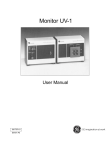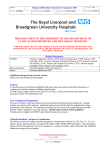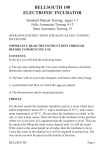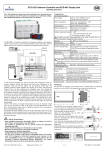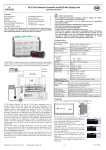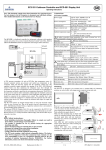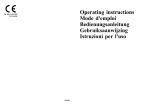Download マニュアル Uvicord SII
Transcript
user manual Uvicord SII i 80-1304-10 Edition AK 1 Important Information Uvicord, FPLC and Drop Design are trademarks of GE Healthcare Bio-Sciences Ltd. AGE Healthcare are trademarks of General Electric Company. All goods and services are sold subject to the Conditions of Sale of the company within the General Electric Company group wich supplies them. A copy of the these terms and conditions is available on request. GE Healthcare Bio-Sciences AB Björkgatan 30, SE-751 84 Uppsala Sweden GE Healthcare Bio-Sciences Ltd GE Healthcare Place Little Chalfont Bucks, Buckinghamshire HP7 9NA England GE Healthcare Bio-Sciences Corp 800 Centennial Avenue, Piscataway, New Jersey 08855 USA GE Healthcare Europe GmbH Postfach 5480 D-79021 Freiburg Germany GE Healthcare Bio-Sciences KK Sanken Building, 3-25-1 Shinjuku-ku, Tokyo 169-0073 Japan 2 Contents 1. Introduction ....................................................................... 3 2. General description ............................................................ 4 2.1 Basic principle .............................................. 4 2.2 Front panel controls ..................................... 5 2.3 Back panel controls ...................................... 6 3. Installation ......................................................................... 7 3.1 Site Requirements ......................................... 7 3.2 Unpacking .................................................... 7 3.3 Electrical connections ................................... 7 3.4 Installation of the filter ................................. 8 3.5 Installation of the UV lamp .......................... 9 3.6 Installation of the flow cell for Standard Chromatography ......................... 10 3.7 Installation of HiFlo flow cells for industrial applications. ......................... 13 3.8 Installation and connection of HPLC/FPLC flow cells ............................... 14 3.9 Connecting a recorder or printer plotter ............................................. 16 3.10 Connecting an integrator ............................ 18 4. Operation ......................................................................... 17 4.1 Start up ...................................................... 17 4.2 Stabilisation time ........................................ 17 4.3 Selection of Time constant .......................... 17 4.4 Baseline adjustment .................................... 18 4.5 Shutdown ................................................... 18 5. Maintenance ..................................................................... 19 5.1 Instrument housing .................................... 19 5.2 General precautions ................................... 19 5.3 Cleaning the flow cells................................ 19 General recommendations .......................... 19 Particulate contaminants ............................ 19 Non-particulate contaminants .................... 19 5.4 Disassembling HPLC/FPLC flow cells .................................................... 21 5.5 Interference filters....................................... 25 5.6 Other optical surfaces................................. 25 6. Technical Specifications.................................................... 28 3 4 1. Introduction 1. Introduction GE Healthcare Uvicord™ SII Code No. 18-1004-50 is a compact single beam UV-monitor with flow-through cell for monitoring the eluant from various column separations. Available wavelengths, selected by a combination of lamp and interference filter are 206, 226, 254, 280, 313, 365 and 405 nm. GE Healthcare Uvicord SII is housed up in one combined optical and electronic unit. This detector simultaneously produces two absorbance outputs - one fixed at 2 AUFS and one selectable from 0.005 - 2 AUFS in 9 steps. Thus, with the selection of the appropriate absorbance range, Uvicord SII enables monitoring of both high and low concentration substances simultaneously with a dual-channel recorder. Substances such as non-aromatic peptides, amino acids, lipids, nucleotides and certain carbohydrates have strong absorption at 206 nm whereas at higher wavelengths they show little or no absorption. Furthermore, most proteins also exhibit greater absorption at 206 nm than they do at 280 nm. By employing all fully integrated electronics and the very latest detection principles Uvicord SII performs to specification at ambient temperature and under cold room conditions. 5 2. General description 2. General description 2.1 Basic principle Light from the high frequency excited gas discharge lamp is filtered by the interference filter before passing through the measuring cell. The light transmitted through the measuring cell is focused onto the measuring detector and converted to an electrical signal. This signal is directly proportional to the light intensity and is amplified by the following linear amplifier, the gain of which is controlled by the “Zero“ adjust potentiometer. Filtered light also falls on the Reference Detector. The reference signal is then amplified in the reference amplifier. This signal is directly proportional to the light intensity. It is used to control the lamp driver for obtaining constant and stable light from the lamp. The reference signal is also connected to the Logarithmic Converter. The Log-Converter receives both the reference signal and the measured signal. The ratio between these two signals is tranformed by the converter and conveyed to the two output amplifiers. One of the Output Amplifiers has preset fixed gain which produces 1 volt and 100 mV outputs corresponding to 2 Absorbance Units. The other output amplifier has its gain controlled by the range switch. The full scale output signal from this amplifier is 100 mV which corresponds to a full scale absorbance of 0.005 to 2 AU, depending upon the range switch setting. This output signal is also fed through the output filter which time constant is selectable by a front panel switch. A zero indicator connected to the output signal is used to adjust the baseline to a reading close to the zero volt. The final zero adjustment is then carried out on the recorder. In order to ensure stable emission and long lamp life the lamp holder is thermostated. The thermostat is set to switch on heating when the lamp temperature goes below ambient temperature (>22°C). Fig. 1. Block Diagram 6 2. General description 2.2 Front panel controls Fig. 2. Front panel No. Item Description 1 Lamp holder The chosen monitoring wavelength determines which lamp shall be used. Each lamp type is identified by a figure (1) or (2) on the end of lamp. Choice of lamp 1 or 2 is determined by the selected monitoring wavelength. 2 Filter holder The filter holder has a spring-loaded locking mechanism for quick release of the filter. The holder can be inserted into the instrument either way. 3 Cell holder The complete cell holder is quickly removed by unscrewing the knob (15) on the back panel. 4 or Time constant selector Selector for the desired time constant (0.5, 1, 2, 5, 10 s). 5 Baseline adjust Ten-turn potentiometer to adjust the absorbance baseline on the recorder outputs. 6 Baseline indicators Two lamp indicators for remote recorder baseline setting. 7 Absorbance range selector Selector for the desired absorbance range 0.005, 0.01, 0.02, 0.05, 0.1, 0.2, 0.5, 1 or 2 AU full scale deflection). 8 Indicator lamp Indicates power is on. 7 2. General description 2.3 Back panel controls 11 10 9 12 13 14 15 16 17 18 Fig. 3. Back panel No. Item Description Mains power inlet Inlet for the mains cable. 10 Mains power switch The Uvicord SII is turned on by pressing the upper half of the rocker switch. The indicator lamp will light to show that mains voltage is on. 11 Fuse holder Main fuses: 2 x for 220-240 V, 125 mAL 2 x for 100-120 V, 250 mAL 9 12 Mains voltage selector 240V. Selects mains voltage 100, 115, 120, 220, 13 to With the calibration potentiometer it is possible Calibration potentiometer compensate for tolerances in optical path length. 8 14 Mounting bracket For attaching to laboratory rod. 15 Cell holder release knob For quick release and optical alignment of flow cell. 16 Integrator output Output for integrator 2 AUFS = 1V. 17 Absorbance output Output for potentiometric recorders. 18 Fixed 2 AU output 2:nd channel output for potentiometric recorder with a dual pen. 3. Installation 3. Installation 3.1 Site Requirements Uvicord SII should be installed on a stable, flat surface away from all sources of vibration. The atmosphere should be free of both excess humidity and corrosive or contaminated vapours which may form deposits on the components in the optical path. Uvicord SII can be installed either in a coldroom or at the ambient temperature in the laboratory. To minimise drift, the temperature should be kept constant. Uvicord SII should be positioned away from all sources of draught, heat and direct sunlight. Uvicord SII should be placed away from any compressor and the fan stream from coldboxes and coldrooms. To ensure stable emission and long lamp life, the lamp holder is thermostated. The thermostat is preset to automatically switch on a heater when the lamp temperature falls below 30°C. One mains power point is required to operate Uvicord SII. Separate power points are required for all ancillary equipment, such as a recorder or printer plotter. The power consumption of the monitor is 20 VA. 3.2 Unpacking Note: It is important that the interference filters, lamps and flow cells should not be handled during unpacking. For protection of these items, they can remain in their packing materials until required for use. Carefully unpack Uvicord SII. Check the contents against the packing list supplied. Inspect for any damage that may have occurred during transit. Report any damage immediately to the local GE Healthcare representative and to the transport company concerned. Save the packing material if future transport can be forseen. 3.3 Electrical connections The instrument is supplied with mains cables and fuses for both 100120 V and 220-240 V operation. 1. Ensure that the mains power switch (3:10) on the back panel is in the OFF, 0 position. 2. Check that the mains voltage selector (3:12) on the back panel is set to the mains voltage in the laboratory. If necessary, use a coin or a screwdriver to adjust the selector to the appropriate voltage. Note: Use the 220 V setting for 230 V mains outlet. 3. Select the correct value of fuse from the fuse kits supplied. For 100120 Volt operation, use the 250 mA fuse supplied. For 220-240 Volt operation, use the 125 mA fuse supplied. Insert the fuse into the fuse cap, and then fit the fuse cap into the fuse holder on the back panel (3:11) of the instrument. 9 3. Installation 4. Connect the instrument to a grounded mains outlet (3:9). Note: Do NOT switch on. 3.4 Installation of the filter Note: Special care must be taken when handling interference filters. Do NOT touch the filter surface. The filters should not be allowed to come in contact with any liquid or exposed to temperatures above 60°C. For directions on cleaning interference filters, refer to Section 5.4. 19 Fig. 4. The interference filter with holder 1. Select the appropriate filter for the wavelength to be used. 2. To mount the filter into the filter holder, depress the spring loaded lock (4:19) on the filter holder. Using forceps, gently insert the filter. Release the lock to hold the filter firmly in position. Either surface of the filter can face towards the lamp. 3. Insert the filter holder into the filter holder housing. The filter holder may be inserted into the monitor either way up. 10 3. Installation 3.5 Installation of the UV lamp Note: Particular care should be taken to avoid touching the transparent tube of the lamp. Handling the lamp with the fingers will leave deposits which will subsequently burn into the surface. 1. Select the appropriate lamp for the wavelength (Fig. 5). Select lamp type 1 for 206, 226 and 280 nm. Select lamp type 2 for 254, 313, 365 and 405 nm. 2. Insert the lamp into the lamp holder on the left side of the instrument (Fig. 6). Note: Once the lamp is installed and stabilised, Uvicord SII should not be bumped or tilted since this may cause a disturbance in the distribution of active material inside the lamp, resulting in changes in light intensity. Warning: If lamp type 2 is accidentally broken, carefully remove all mercury and glass to prevent mercury poisoning. Follow local safety regulation when disposing of mercury waste. Fig. 5. The UV lamps with the type number indicated Fig. 6. Inserting the UV lamp. 11 3. Installation 3.6 Installation of the flow cell for Standard Chromatography The flow cell (80-1080-47) included in Standard Chromatography, 801080-49 flow cell holder has a path length of 2.5 mm or 5 mm and is designed for flow rates up to 1 l/h. The flow cell and the cell holder are supplied unmounted. Carefully unpack the parts supplied and follow the instructions below for mounting the flow cell in the holder. When assembled, insert the flow cell into the Uvicord SII and tighten it in position using the knob (3:15) on the back panel. For alternative flow cells to 80-1080-49 flow cells holder, see section 7. Fig. 7 a. Fit the cell collars onto the cell holder spring. Fig. 7 b. Feed the flanged tubing into each cell collar. 12 3. Installation Fig. 7 c. Clean the flow cell with lens tissue. Use forceps to insert the flow cell into the neck of the tubing. Fig. 7 d. Push the spring-loaded lever upwards and then insert the flow cell into the holder. Turn the cell so that the side with the required path length is next to the aperture. Release the lever to secure the cell in position. 13 3. Installation Fig. 7 e. Loosen and remove the connector screws and split ferrules and then feed the tubing through the inlet and outlet on the back of the cell holder. Fit the split ferrule and connector onto the tubing and then tighten the connector until fully finger-tigh. Fig. 7 f. The cell can now be inserted into Uvicord SII and secured in position by tightening the knob in the back panel. The inlet of the flow cell is the lower connector. 14 3. Installation 3.7 Installation of HiFlo flow cells for industrial applications. Fig. 8. Industrial HiFlo flow cell Two types of HiFlo cells are available for use with Uvicord SII in industrial applications where high flow rates are required. 80-1080-50 Flow cell holder, complete with HiFlo cell, 1 mm path length, back pressure <1 bar at flow rate 100 l/h. 80-1080-51 Flow cell holder, complete with HiFlo cell, 2.5 mm path length, back pressure <1 bar at flow rate 350 l/h. HiFlo cells are supplied mounted in the holders, ready to be istalled directly into the cell housing. Insert the HiFlo cell holder into the cell housing and tighten it into position using the knob (3:15) on the back panel. 15 3. Installation 3.8 Installation and connection of HPLC/FPLC flow cells Code No. Material GE Healthcare HPLC/FPLC™ flow cells are available in, titanium and in stainless steel (Figs. 9 a) for use when the cell could be exposed to corrosive materials. Each flow cell is supplied mounted in the holder, ready for immediate installation into the Uvicord SII. All flow cells have a maximum pressure limit of 25 bar. The cells are described below. Path length Cell volume Capillary OD Capillary ID Flow rate Backpressure 80-1251-83 titanium 2.5 mm 8 µl 1.6 mm 0.35 mm 20 ml/min <1 bar 80-1251-84 titanium 1.5 mm 5 µl 1.6 mm 1.0 mm 100 ml/min <1 bar Fig. 9 a. 80-1251-83/80-1251-84 1. Insert the flow cell holder into the cell housing and secure by tightening the knob (3:15) on the back panel. 2. Remove the rubber cover from the end of both the inlet and the outlet tubes. 3. Before use, flush the flow cell with at least 50 ml methanol at a flow rate of 1 ml/min. 4. Connect to the HPLC/FPLC system, following the guidelines below. The inlet and outlet capillaries of both types of titanium HPLC/FPLC flow cells have an OD of 1.6 mm. Wherever possible dilution and loss of resolution should be prevented by connecting the column outlet directly to the flow cell inlet. 16 3. Installation For connections to the titanium flow cells, use titanium compression screws (18-1002-32) and inert polymer ferrules (80-1027-55). When making any connection, fit the compression screw onto the tubing and then fit the ferrule with the cone pointing towards the end of the tubing. Push the tubing firmly into the connector and tighten the compression screw until finger-tight. To seal the connection, use a 1/4 inch wrench to tighten the compression screw a further 1/6th of a turn for inert polymer ferrule or 1/12th of a turn for stainless steel. Take great care not to damage the connector by overtightening the compression screws. At the outlet of the flow cell, connect a Teflon tube < 0.8 mm ID to the flow cell outlet (upper connector). It is recommended that the outlet of the waste tube should be placed about one meter above the cell. This will maintain a positive pressure in the flow cell and will prevent the formation of air bubbles. This pressure will also reduce sensitivity to fluctuations in flow from the HPLC/FPLC pump. 3.9 Connecting a recorder or printer plotter There are two 100 mV signal output ports on the back panel. These are for use with GE Healthcare recorders, REC 111, REC 112 or similar instruments. One output (3:17), marked 0.1V REC 0.005 - 2 AU, provides the absorbance signal selected with the range selector switch on the front panel (2:7). The other output (3:18), marked 0.1 V 2 AU, provides the fixed 2 AU range signal. Fig 10 shows how to connect one or both outputs to a 2-channel GE Healthcare REC 112 recorder using the two 80-1080-53 recorder cables supplied. Red Black Red Black Fig. 10. 17 4. Operation 4. Operation 4.1 Start up Note: Always ensure that all liquids passing through the flow cell are degassed to prevent any air bubble formation in the cell. Liquids must be filtered to remove any particulate material and prevent blockage. 1. Check that the correct filter and lamp for the desired wavelength have been fitted. Ensure that the correct flow cell is in position. 2. If the instrument has been switched off, turn on the mains power switch (3:10) and refer to Section 4.2, to restabilise the instrument. The LAMP ON indicator on the front panel illuminates. Note: If the UV lamp does not ignite, remove the lamp and gently rub the glass bulb with a clean cloth to produce a small static charge. Re-insert the lamp. 4.2 Stabilisation time At normal laboratory temperatures, the UV lamp requires 30 minutes to stabilise sufficiently for work in the 2 AU to 0.5 AU ranges. A stabilisation period of 4 hours is required for work in the 0.2 AU to 0.005 AU ranges. When the Uvicord SII is in constant use, it is recommended that it remains switched on. Uvicord SII can be switched off when not in use for periods of one week or more. For coldroom operation below 10°C, install Uvicord SII in the coldroom at the desired running temperature at least 12 hours before the start of a run. This is necessary to allow the instrument housing to equilibrate to the temperature of the cold room. Once this equilibration has taken place, the stabilisation times given for normal laboratory temperatures are valid. To ensure stable emission and long lamp life, the lamp holder is thermostated. The thermostat is preset to switch on a heater automatically when the lamp temperature falls below 30°C. 4.3 Selection of Time constant 18 After stabilisation, use the Time constant selector switch (2:4) to set the desired time constant. 0.5 seconds - Fast response for normal conditions. 1 or 2 seconds - Slow response for suppressing short term noise. 5 or 10 seconds - Slowest response for maximum suppression of noise. 4. Operation 4.4 Baseline adjustment 1. Adjust the zero position (right hand side of the chart) on the recorder by short circuiting the input or pressing the zero check knob on the recorder. 2. Adjust with the zero knob on the recorder. 3. Set the absorbance range selector at 2 AU, (Fig. 2:7). 4. Turn the baseline adjust knob (Fig. 2:5) until both base line indicator lamps are extinguished. If the left indicator lamp is alight turn the knob to the right and the recorder pen will move to the right. If the right indicator lamp is alight turn the knob to the left. 5. Set the absorbance range selector at 0.5 AU, 0.1 AU, 0.02 AU, 0.005 AU and repeat (4) between each absorbance range setting. 6. Set the operating absorbance range. 7. Adjust the zero point on the recorder to get the base line (normally 5 to 10 divisions to allow for negative trends). 4.5 Shutdown 1. On completion of the chromatographic run, flush the flow cell either pure solvent or the buffer used in the chromatographic run. To prevent the deposition of salts from aqueous buffers, flush the cell with distilled water after use, if necessary after disconnecting from the column. Note: Never allow aqueous buffers to dry out in the cell. Either continue to flush through with buffer or leave the cell filled with distilled water. 2. Leave Uvicord SII switched on. The monitor should only be switched off if it is not going to be used again for more than one week. 19 5. Maintenance 5. Maintenance 5.1 Instrument housing Wipe the surfaces regularly with a damp cloth. Let the instrument dry completely before use. 5.2 General precautions To ensure trouble free running, users are advised to observe the following precautions: - All liquids passing through the flow cell should be free of suspended particles. - All liquids should be degassed to prevent air bubble formation in the flow cell. - Never allow buffer solutions to dry out in the flow cell. Always rinse the flow cell thoroughly with distilled water after use. - Handle interference filters with care. Never touch the optical surfaces or expose them to temperatures above 60°C. - When not in use, always store interference filters in the container in which they were supplied. 5.3 Cleaning the flow cells General recommendations For trouble free operation of the Uvicord SII, it is essential that the flow cell is free of any particulate matter and contaminant films. Ensure that the flow cell is never allowed to dry out without having been thoroughly rinsed. Liquids containing dissolved salts, proteins or other solutes will dry out, leaving contaminants on the inner optical surface of the flow cell. The flow cell can be inspected for contaminants without disconnecting it from the chromatography system. To do this, unscrew the cell holder release knob on the back panel (3:15) and pull the flow cell holder carefully out of the instrument. If contamination is visible, follow the cleaning instructions in the next sections. Note: For care and maintenance of the stream splitter flow cells please refer to the separate instruction sheet supplied with the cells. Particulate contaminants 1. Disconnect from the chromatography system and then remove the flow cell holder from the Uvicord SII. 2. Connect a syringe to the outlet tubing (upper) and back-flush the cell with water and then small volumes of clean 50% (v/v) ethanol in water. Collect the rinsing liquid in a clean beaker. 3. Examine the cell and the contents of the rinsing liquid beaker from time to time to check that all the particles have been washed out. 20 5. Maintenance 4. Rinse the cell with about 100 ml of distilled water. Replace it in the Uvicord SII and reconnect to the chromatography system. Non-particulate contaminants Most non-particulate contaminants, e.g. denatured proteins, salts, etc. can be removed by flushing the cell with a warm solution of laboratory detergent or other appropriate solvent. Finally, rinse the cell thoroughly with distilled water or clean solvent. Oily deposits, which increase the tendency to trap bubbles, can be removed by rinsing the flow cell first with a non-polar solvent (e.g. hexane), then with a polar solvent (e.g. isopropanol) and finally with distilled water. If the flow cell has been used with aqueous solutions, it should be rinsed in the following sequence: - Warm aqueous laboratory detergent solution - Distilled water - Polar solvent - Non-polar solvent - Polar solvent - Distilled water 5.4 Disassembling HPLC/FPLC flow cells Titanium HPLC flow cell (80-1251-83/80-1251-84) To disassemble the titanium flow cells, follow the instructions below. Note: Inner and outer packings and ferrules cannot be reused. Parts required 80-1251-85 Packing set, including 4 inner and 4 outer Teflon packings or 80-1252-96 Window set, including 2 quartz windows, 4 inner and 4 outer Teflon packings 80-1027-55 Inert polymer ferrules 80-1250-92 Titanium capillary 0.35 mm ID, 1/16" (1.6 mm) OD, for 80-1251-83 80-1250-93 Titanium capillary 1.0 mm ID, 1/16" (1.6 mm) OD, for 80-1251-84 21 5. Maintenance Fig 11 a. Loosen the two securing screws and remove the flow cell block from the black holder Fig. 11 b. Use a 1/4 inch wrench to loosen the compression screws. Remove the capillary tubing. Fig. 11 c. Use a screwdriver to remove the split securing screw. 22 5. Maintenance Fig. 11 d. Use an applicator stick or scalpel to remove the outer packing. Fig. 11 e. Turn the cell upside down and tap it to remove the quartz window. Remove the inner packing. Fig. 11 f. Disassemble the other side of the flow cell in the same way. Flush both sides with alcohol to clean the inner surfaces. Alternatively, immerse in alcohol in an ultrasonic bath. 23 5. Maintenance Fig. 11 g. Clean the quartz windows using lint-free tissue soaked in alcohol. Reassemble both sides of the cell using new inner and outer packings. If necessary, select new titanium capillary. Fit a new ferrule onto the capillary and refit the capillary to the flow cell block. Tighten using a 1/4 inch wrench. Fig. 11 h. Feed the inlet and outlet ends through the black holder. Refit the flow cell block to the black holder. Flush the cell through with alcohol again to check for leaks. 24 5. Maintenance 5.5 Interference filters For optimum performance, it is essential that the interference filters are clean and free of any particulate material. Do not touch the interference filters. Should the filter become contaminated with dust, finger prints or oil, proceed as follows: - Carefully take the filter from the filter holder without touching or scratching the surface (see Section 3.4). - Use lens cleaning tissue dipped in ethanol to gently clean both sides of the filter surface. - Place the clean filter back into the filter holder or into its protective box. - Interference filters should never be exposed to temperatures above 60°C. 5.6 Other optical surfaces Clean all other optical surfaces by wiping the surface with a clean, lint-free cloth, moistened with carbon tetrachloride, ethanol, or another suitable pure solvent. 25 6. Technical Specifications 6. Technical Specifications Operating wavelengths 206, 226, 254, 280, 313, 365 and 405 nm. Absorbance ranges 0.005, 0.01, 0.02, 0.05, 0.1, 0.2, 0.5, 1 and 2 AUFS. Noise <1x10-4 AU measured peak to peak in a dry cell. Drift <5x10-4 AU/h at constant temperature. Environment +0 to +30 °C, 20-95% relative humidity, 84-106 kPa (840-1060 mbar) atmospheric pressure. Recorder outputs 100 mV for selected absorbance range and 100 mV for fixed 2A range. Integrator output 1 V = 2 AU. Power consumption 20 W. Mains Voltage 100/115/120/220-230/240V, 50-60 Hz. Dimensions (LxWxH) 313 x 131 x 147 mm. Weight 4.3 kg. EMC standards This product meets the requirement of the EMC Directive 89/336/EEC through the harmonized standards EN 50081-2 (emission) and EN 50082-1 (immunity) Note: This is a class A product. In a domestic environment this product may cause radio interference in which case the user may be required to take adequate actions. Note: The declaration of conformity is valid for the instrument when it is : • used in laboratory locations • used in the same state as it was delivered from GE Healthcare Bio-Sciences AB except for alteration described in the User Manual Safety standards 26 • used as "stand alone" unit or connected to other CE labelled GE Healthcare products or other products as recommended This product meets the requirement of the Low Voltage Directive (LVD) 73/23/EEC through the harmonized standard EN 61010-1. 7. Accessories and Spare Parts 7. Accessories and Spare Parts Please order accessories and spare parts according to the designation and code numbers given below. Designation Code No. Pieces Interference filter for 206 nm 80-1071-11 1 Interference filter for 254 nm 80-1071-12 1 Interference filter for 280 nm 80-1071-13 1 Interference filter for 226 nm 80-1071-14 1 Interference filter for 313 nm 80-1071-15 1 Interference filter for 365 nm 80-1071-16 1 Interference filter for 405 nm 80-1071-17 1 Filter holder 80-1080-63 Lens cleaning tissue 80-1193-78 50 Lamp type 1, for 206, 226 and 280 nm 18-1004-94 1 Lamp type 2, for 254, 313, 365 and 405 nm 18-1004-95 1 Designation Code No. Pieces Flow cell holder and quartz glass flow cell, unmounted, 70 µl cell volume, 2.5 or 5 mm path length for Standard Chromatography. 80-1080-49 1 Flow cell holder, complete with inert flow cell for HPLC/FPLC, titanium, 8 µl cell volume, 2.5 mm path length, back pressure at 20 ml/min <1 bar, 25 bar pressure limit. 80-1251-83 1 Flow cell holder, complete with inert flow cell for HPLC/FPLC, titanium, 5 µl cell volume, 1.5 mm path length, back pressure at 100 ml/min <1 bar, 25 bar pressure limit. 80-1251-84 1 Flow cell holder, complete with HiFlo cell, 1 mm path length, back pressure at 100 l/h <1 bar. 80-1080-50 1 Flow cell holder, complete with HiFlo flow cell, 2.5 mm 80-1080-51 path length, back pressure at 350 l/h <1 bar. 1 Filters Lamps Flow cells 27 7. Accessories and Spare Parts Alternative flow cells for the 80-1080-49 flow cell holder Path length (mm) Volume (ml) Cross section Max flow rate at 150 cm water head (l/h ) Cells Code No. Pieces 2.5 or 5 2.5 3 0.07 0.03 0.1 rectangular rectangular circular 1 1 1 80-1080-47 80-1080-52 80-1080-66 1 1 1 Designation Code No. Pieces Accessories and Spare Parts Packing set for 2510-100/101 inert HPLC cells includes; Teflon packings for quartz windows, 2 sets of 4 80-1251-85 Window set for 2510-100/101 inert HPLC cells includes; 2 quartz windows, Teflon packings, 2 sets of 4 80-1252-96 Packing set for 2138-104 stainless steel HPLC cell includes; Teflon packings for quartz windows, 2 sets of 4 80-1044-21 Window set for 2138-104 stainless steel HPLC cell includes; 2 quartz windows, Teflon packings, 2 sets of 4 80-1044-22 Inert polymer ferrule 80-1027-55 5 Compression screw, titanium 18-1002-32 5 Inert capillary, precut titanium OD 1/16" (1.6 mm), ID 0.35 mm, 125 mm long. 80-1250-92 1 Inert capillary, precut titanium OD 1/16" (1.6 mm), ID 1.0 mm, 125 mm long. 80-1250-93 1 Recorder cable (BNC-Banana) for connecting GE Healthcare recorder and integrator 80-1080-53 1 Mains cable US 19-2447-01 1 Mains cable EUR 19-2448-01 1 19-2925-01 1 Cables Electrical Spares Fuse cap for 220 V (EUR) 28 5. Maintenance 29 30 Printed in Sweden by TK i Uppsala AB, 2003






























